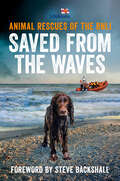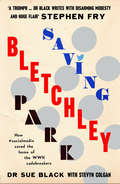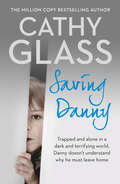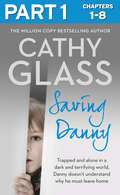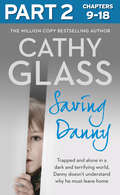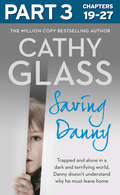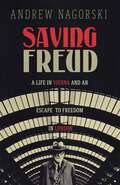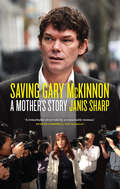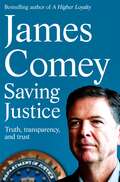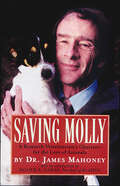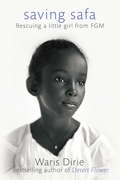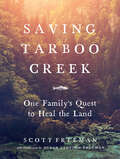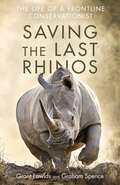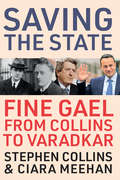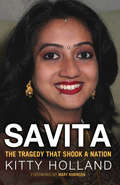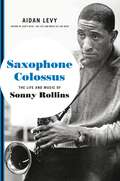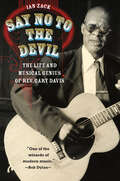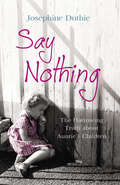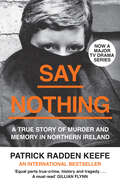- Table View
- List View
Saved from the Waves: Animal Rescues Of The Rnli
by The RNLIShe has to be OK, I pleaded silently to myself. She has to be. ‘We’ve alerted the RNLI and they’re sending a lifeboat out.’ ‘The RNLI?’ I said, surprised. ‘They do that?’
Saving Bletchley Park: How #socialmedia saved the home of the WWII codebreakers
by Sue Black Stevyn ColganImagine a Britain where the most important sites of historical significance are replaced with housing estates and supermarkets…Imagine a Britain without Bletchley Park, where Alan Turing and a team of code breakers changed the course of World War II and where thousands of women inspired future generations with their work in the fields of computing and technology...Now imagine a group of extraordinary people, who – seventy years after the birth of the modern computer at Bletchley Park – used technology to spark a social media campaign that helped secure its future and transform it into the world-class heritage and education centre it deserves to be.This is a story about saving Bletchley Park.But it is also the story of the hundreds of people who dedicated twenty years of hard work and determination to the campaign that saved it. It is a testament to the remarkable and mysterious work during World War II that made it a place worth saving. It is a book about campaigners, veterans, enthusiasts, computer geeks, technology, Twitter, trees and Stephen Fry stuck in a lift.And finally, it is a story about preserving the past for the generations of tomorrow.
Saving Danny
by Cathy GlassThe fifteenth fostering memoir by Cathy Glass.Danny was petrified and clung to me in desperation as I carried him to my car. Trapped in his own dark world, he couldn't understand why his parents no longer loved or wanted him, and were sending him away.
Saving Danny: Part 1 of 3
by Cathy GlassThe fifteenth fostering memoir by Cathy Glass.Danny was petrified and clung to me in desperation as I carried him to my car. Trapped in his own dark world, he couldn't understand why his parents no longer loved or wanted him, and were sending him away.
Saving Danny: Part 2 of 3
by Cathy GlassThe fifteenth fostering memoir by Cathy Glass.Danny was petrified and clung to me in desperation as I carried him to my car. Trapped in his own dark world, he couldn't understand why his parents no longer loved or wanted him, and were sending him away.
Saving Danny: Part 3 of 3
by Cathy GlassThe fifteenth fostering memoir by Cathy Glass.Danny was petrified and clung to me in desperation as I carried him to my car. Trapped in his own dark world, he couldn't understand why his parents no longer loved or wanted him, and were sending him away.
Saving Freud: A Life in Vienna and an Escape to Freedom in London
by Andrew Nagorski'Astonishing... In the American journalist Andrew Nagorski this tale has found its ideal narrator'SEBASTIAN FAULKS, Sunday Times'A gripping masterpiece'BRETT KAHR, Freud Museum LondonMarch 1938: German soldiers are massing on the Austrian border, on the cusp of fulfilling Hitler's dream of absorbing the country into the Third Reich. Many Jews make frantic plans to flee to safety. But one of the most famous men in the world, unable to contemplate leaving his beloved Vienna, is not among them. His name is Sigmund Freud.Saving Freud is the story of a great man's life, and of the extraordinary people who managed to prolong it, by convincing him to escape to London: the Welsh physician who brought psychoanalysis to Britain; Napoleon's great-grandniece; an American ambassador; Freud's devoted daughter, Anna; and the doctor who risked his own life by staying at Freud's side.In examining the histories of both Freud and his closest circle, Andrew Nagorski brilliantly evokes the story of Europe in the first half of the Twentieth Century. This is a tale of a great city, a collapsing empire, a rising terror -and of a man who would change the way we think.
Saving Gary McKinnon: A Mother's Story
by Janis SharpThe ordinary lives of Gary McKinnon and his mother Janis changed dramatically one morning in 2002 when police interviewed Gary about hacking into US government computers. Three years later, on 7 June 2005, he was arrested. Extradition seemed certain and so, fearing that Gary would take his own life rather than be taken away, Janis began her extraordinary battle. Facing up to sixty years' incarceration, Gary was vilified by the authorities, who described his actions as 'the biggest military computer hack of all time'. The truth was rather less dramatic - Gary was searching for signs of UFOs. When he discovered that thousands of NASA and Pentagon computers had no passwords or firewalls he started to leave notes warning that their security was deeply flawed. It was only in 2008 after a TV interview that an expert in autism phoned Gary's solicitors and said he was sure that Gary was suffering from Asperger's syndrome. The stakes were now even higher. The US judiciary had all the might of the world's greatest power. But it had not reckoned on Gary's mother. This is the story of how one woman squared up not only to the Pentagon but also to the British judicial and political systems. It is a book about a mother who took on the world and won.
Saving Izzy: The Abandoned Dog Who Stole My Heart
by Jon KatzWhen Jon Katz hears about Izzy, a three-year-old Border collie kept alone in a field on an abandoned farm, his heart speaks louder than his head and he agrees to take him in.Once again Jon finds himself challenged by a difficult dog. Having found his human, Izzy wants to go with Jon wherever he may be, and jumps fences and chews through locks to do so. Jon has been through this before with his dog Orson, and isn't sure he can cope with the responsibility and potential heartache again. But Jon's motley collection of animals - from Jesus the baby donkey to Elvis the surprisingly sociable steer, as well of course as farm manager and Border collie Rose - form an ideal refuge for Izzy. And as Jon and Izzy decide they are perfect companions, Jon realises just how much life on the farm has taught him about patience, perseverance and love.Please note, Saving Izzy is the UK title for the book published in the US as Dog Days.
Saving Justice: Truth, Transparency, and Trust
by James Comey'An absolutely fascinating read.'Emily MaitlisJames Comey, former FBI Director and Sunday Times number one bestselling author of A Higher Loyalty, uses his long career in federal law enforcement to explore issues of justice and fairness in the US justice system.James Comey might best be known as the FBI director that Donald Trump fired in 2017, but he’s had a long, varied career in the law and justice system. He knows better than most just what a force for good the US justice system can be, and how far afield it has strayed during the Trump Presidency.In his much-anticipated follow-up to A Higher Loyalty, Comey uses anecdotes and lessons from his career to show how the federal justice system works. From prosecuting mobsters as an Assistant US Attorney in the Southern District of New York in the 1980s to grappling with the legalities of anti-terrorism work as the Deputy Attorney General in the early 2000s to, of course, his tumultuous stint as FBI director beginning in 2013, Comey shows just how essential it is to pursue the primacy of truth for federal law enforcement.Saving Justice is gracefully written and honestly told, a clarion call for a return to fairness and equity in the law.
Saving Molly: A Research Veterinarian's Choices
by James Mahoney D.V.M., Ph.D.The puppy was dying when James Mahoney found her. Molly was not the first dying animal the research veterinarian had seen. But Molly's struggle sent him barreling over rough Jamaican mountains in a borrowed car, searching for the equipment he'd need to save her. More than a story about a dog, this is the story of a rescued man. He asks himself questions: How can he spend his days with chimpanzees locked behind bars and still say that he loves them? What do we owe them for their participation in AIDS research? Why is saving a single runt puppy important? In the tradition of James Herriot, Mahoney's story spans fifty years of living with animals and with the two-legged primates who study them. Written by the man Jane Goodall called "one of the most gentle and compassionate people I know," Saving Molly is an important addition to the debate on animal research and a heartfelt meditation on one man's life. With an introduction by Roger A. Caras, president of the ASPCA."He is concerned about the pain and the suffering of the animals. That's what makes Jim Mahoney different." --Alex Pacheco, founder of PETA
Saving Safa: Rescuing a Little Girl from FGM
by Waris DirieWaris Dirie, the Somalia nomad who became a supermodel, and an anti-FGM activist, first came to the world's attention with the publication of her autobiography, Desert Flower. The book was subsequently made into a film and little Safa Nour, from one of the slums of Djibouti in the Horn of Africa, was chosen to play the young Waris. The book and the film record many extraordinary things - from facing down a tiger, to being discovered by a famous photographer in London - but it also tells the grim story of female circumcision, an ordeal that the young Waris had to endure. Saving Safa opens with a letter from Safa, now aged seven, who explains that she is worried that she will undergo FGM in spite of the contract her parents have signed with Dirie's Desert Flower Foundation stating that they will never have their daughter cut. Waris drops everything and flies to Djibouti where she meets Safa's father and mother who thinks her daughter should be cut to stop the community ostracising them. As Safa was saved from FGM through a contract with her parents, the Foundation believes a thousand other girls can be saved through providing their families with aid in return for a promise not to mutilate their daughters
Saving Tarboo Creek: One Family's Quest to Heal the Land
by Scott FreemanExamine the most pressing environmental issues of our time through one family&’s detailed account of creek restoration. Equal parts heartfelt and enlightening, Saving Tarboo Creek explores how the Freeman family lived a more authentic, fulfilling, and natural life one sapling and one acre at a time.
Saving the Last Rhinos: The Life of a Frontline Conservationist
by Graham Spence Grant FowldsEach year, more than one thousand rhinoceroses are killed - in South Africa alone. There are fewer than 18,000 white rhinos and only 5,000 black rhinos left alive in the wild. The situation with regard to this corrupt, illegal war on wildlife is clearly critical.And what are rhinos killed for? Their horns - sold in shavings as a snake-oil 'cure' for colds or impotence. The going price is $16,000 a kilogram, but a rhino's horn is simply keratin, the same material as our fingernails, with no magical, medicinal properties.Grant Fowlds is a passionate conservationist on the front line of protecting these iconic animals - right now, against armed poachers; but in the longer term, too, through his work with schoolchildren, communities and policymakers. He is fiercely focused on highlighting the alarming increase in rhino poaching, a scourge which has put these mighty animals at serious threat of extinction. He is a partner of Rhino Art, founded by philanthropic adventurer Kingsley Holgate. Rhino Art's 'Let the children's voices be heard' project aims to gather the largest number of children's 'Art Voices' ever recorded, in support of rhino protection, and to use these heartfelt messages from the children of Africa and elsewhere in the world as a rallying cry against rhino poaching.Grant works closely with all the biggest local and global conservation agencies, including the World Wide Fund for Nature (WWF). He has hosted Prince Harry at his family's game lodge, Leeuwenbosch, and the prince is very supportive of Grant's work.
Saving the State: Fine Gael from Collins to Varadkar
by Stephen Collins Ciara MeehanWhen Fine Gael entered a coalition government with Fianna Fáil in 2020 the party did what would have been unthinkable for its forefathers, who had fought and won a bitter civil war to establish the institutions of an independent Irish state almost a century earlier. Saving the State is the remarkable story of Fine Gael from its origins in the fraught days of civil war to the political convulsions of 2020.Written by political journalist Stephen Collins and historian Ciara Meehan, Saving the State draws on a wealth of original historical research and a range of interviews with key political figures to chart the evolution of the party through the lens of its successive leaders.From the special place occupied by Michael Collins in the party’s pantheon of heroes to the dark era of the Blueshirts, and from its role as the founder of the state to its claim to be the defender of the state, the ways that members perceive their own history is also explored.Saving the State is essential reading for anyone interested in understanding how Fine Gael came to be the party it is today, the ways in which it interprets and presents its own history, and the role that it played in shaping modern Ireland.
Savita: The Tragedy That Shook A Nation
by Kitty HollandSeventeen weeks pregnant and facing a miscarriage, Savita Halappanavar and her husband Praveen walked into an Irish maternity ward in October 2012. Unwittingly, the couple also walked into that deeply controversial arena in which Ireland’s legislative position on abortion remained unresolved.A week later, Savita was dead from septicaemia. Reports of her death and of the refusal to allow Savita a termination of her pregnancy sent shockwaves across Ireland and around the world. Once again the subject of abortion was catapulted to the very top of the agenda in Ireland. With the pro-life and pro-choice camps claiming the moral high ground, both sides in the bitterly contested battle sought to appropriate Savita’s story and her image. In the midst of the ensuing rage and furore, the marches and protests, the threats and counter-threats that exploded across political and media platforms, Savita and the complete circumstances of her death were lost. In Savita: The Tragedy That Shook A Nation, Kitty Holland addresses this imbalance as she reveals the truth behind the headlines and explores many unanswered questions: Who was Savita? How significant was it that she was a non-Irish, non-Catholic woman in search of help on Irish soil? And how did her husband and her community’s reaction to her death shape the parameters of the debate which followed? Holland’s exposé also looks at how the tragic circumstances of Savita’s death played a part in compelling the Irish Government to finally legislate on abortion and how activists on each side succeeded or failed in shaping that legislation.
Saxophone Colossus: The Life and Music of Sonny Rollins
by Aidan Levy**Winner of the American Book Award (2023)** **Longlisted for the PEN/Jacqueline Bograd Weld Award (2023)** The long-awaited first full biography of legendary jazz saxophonist and composer Sonny Rollins Sonny Rollins has long been considered an enigma. Known as the &“Saxophone Colossus,&” he is widely acknowledged as one of the greatest jazz improvisers of all time, winning Grammys, the Austrian Cross of Honor, Sweden&’s Polar Music Prize and a National Medal of Arts. A bridge from bebop to the avant-garde, he is a lasting link to the golden age of jazz, pictured in the iconic &“Great Day in Harlem&” portrait. His seven-decade career has been well documented, but the backstage life of the man once called &“the only jazz recluse&” has gone largely untold—until now. Based on more than 200 interviews with Rollins himself, family members, friends, and collaborators, as well as Rollins&’ extensive personal archive, Saxophone Colossus is the comprehensive portrait of this legendary saxophonist and composer, civil rights activist and environmentalist. A child of the Harlem Renaissance, Rollins&’ precocious talent landed him on the bandstand and in the recording studio with Bud Powell, Thelonious Monk, Charlie Parker, Miles Davis and Dizzy Gillespie, or playing opposite Billie Holiday. An icon in his own right, he recorded Tenor Madness, featuring John Coltrane; Way Out West; Freedom Suite, the first civil rights-themed album of the hard bop era; A Night at the Village Vanguard; and the 1956 classic Saxophone Colossus. Yet his meteoric rise to fame was not without its challenges. He served two sentences on Rikers Island and won his battle with heroin addiction. In 1959, Rollins took a two-year sabbatical from recording and performing, practicing up to 16 hours a day on the Williamsburg Bridge. In 1968, he left again to study at an ashram in India. He returned to performing from 1971 until his retirement in 2012. The story of Sonny Rollins—innovative, unpredictable, larger than life—is the story of jazz itself, and Sonny&’s own narrative is as timeless and timely as the art form he represents. Part jazz oral history told in the musicians&’ own words, part chronicle of one man&’s quest for social justice and spiritual enlightenment, this is the definitive biography of one of the most enduring and influential artists in jazz and American history.
Say No to the Devil: The Life and Musical Genius of Rev. Gary Davis
by Ian ZackWho was the greatest of all American guitarists? You probably didn’t name Gary Davis, but many of his musical contemporaries considered him without peer. Bob Dylan called Davis “one of the wizards of modern music.” Bob Weir of the Grateful Dead—who took lessons with Davis—claimed his musical ability “transcended any common notion of a bluesman.” And the folklorist Alan Lomax called him “one of the really great geniuses of American instrumental music.” But you won’t find Davis alongside blues legends Robert Johnson and Muddy Waters in the Rock and Roll Hall of Fame. Despite almost universal renown among his contemporaries, Davis lives today not so much in his own work but through covers of his songs by Dylan, Jackson Browne, and many others, as well as in the untold number of students whose lives he influenced. The first biography of Davis, Say No to the Devil restores “the Rev’s” remarkable story. Drawing on extensive research and interviews with many of Davis’s former students, Ian Zack takes readers through Davis’s difficult beginning as the blind son of sharecroppers in the Jim Crow South to his decision to become an ordained Baptist minister and his move to New York in the early 1940s, where he scraped out a living singing and preaching on street corners and in storefront churches in Harlem. There, he gained entry into a circle of musicians that included, among many others, Lead Belly, Woody Guthrie, and Dave Van Ronk. But in spite of his tremendous musical achievements, Davis never gained broad recognition from an American public that wasn’t sure what to make of his trademark blend of gospel, ragtime, street preaching, and the blues. His personal life was also fraught, troubled by struggles with alcohol, women, and deteriorating health. Zack chronicles this remarkable figure in American music, helping us to understand how he taught and influenced a generation of musicians.
Say No to the Devil: The Life and Musical Genius of Rev. Gary Davis
by Ian ZackWho was the greatest of all American guitarists? You probably didn’t name Gary Davis, but many of his musical contemporaries considered him without peer. Bob Dylan called Davis “one of the wizards of modern music.” Bob Weir of the Grateful Dead—who took lessons with Davis—claimed his musical ability “transcended any common notion of a bluesman.” And the folklorist Alan Lomax called him “one of the really great geniuses of American instrumental music.” But you won’t find Davis alongside blues legends Robert Johnson and Muddy Waters in the Rock and Roll Hall of Fame. Despite almost universal renown among his contemporaries, Davis lives today not so much in his own work but through covers of his songs by Dylan, Jackson Browne, and many others, as well as in the untold number of students whose lives he influenced. The first biography of Davis, Say No to the Devil restores “the Rev’s” remarkable story. Drawing on extensive research and interviews with many of Davis’s former students, Ian Zack takes readers through Davis’s difficult beginning as the blind son of sharecroppers in the Jim Crow South to his decision to become an ordained Baptist minister and his move to New York in the early 1940s, where he scraped out a living singing and preaching on street corners and in storefront churches in Harlem. There, he gained entry into a circle of musicians that included, among many others, Lead Belly, Woody Guthrie, and Dave Van Ronk. But in spite of his tremendous musical achievements, Davis never gained broad recognition from an American public that wasn’t sure what to make of his trademark blend of gospel, ragtime, street preaching, and the blues. His personal life was also fraught, troubled by struggles with alcohol, women, and deteriorating health. Zack chronicles this remarkable figure in American music, helping us to understand how he taught and influenced a generation of musicians.
Say No to the Devil: The Life and Musical Genius of Rev. Gary Davis
by Ian ZackWho was the greatest of all American guitarists? You probably didn’t name Gary Davis, but many of his musical contemporaries considered him without peer. Bob Dylan called Davis “one of the wizards of modern music.” Bob Weir of the Grateful Dead—who took lessons with Davis—claimed his musical ability “transcended any common notion of a bluesman.” And the folklorist Alan Lomax called him “one of the really great geniuses of American instrumental music.” But you won’t find Davis alongside blues legends Robert Johnson and Muddy Waters in the Rock and Roll Hall of Fame. Despite almost universal renown among his contemporaries, Davis lives today not so much in his own work but through covers of his songs by Dylan, Jackson Browne, and many others, as well as in the untold number of students whose lives he influenced. The first biography of Davis, Say No to the Devil restores “the Rev’s” remarkable story. Drawing on extensive research and interviews with many of Davis’s former students, Ian Zack takes readers through Davis’s difficult beginning as the blind son of sharecroppers in the Jim Crow South to his decision to become an ordained Baptist minister and his move to New York in the early 1940s, where he scraped out a living singing and preaching on street corners and in storefront churches in Harlem. There, he gained entry into a circle of musicians that included, among many others, Lead Belly, Woody Guthrie, and Dave Van Ronk. But in spite of his tremendous musical achievements, Davis never gained broad recognition from an American public that wasn’t sure what to make of his trademark blend of gospel, ragtime, street preaching, and the blues. His personal life was also fraught, troubled by struggles with alcohol, women, and deteriorating health. Zack chronicles this remarkable figure in American music, helping us to understand how he taught and influenced a generation of musicians.
Say No to the Devil: The Life and Musical Genius of Rev. Gary Davis
by Ian ZackWho was the greatest of all American guitarists? You probably didn’t name Gary Davis, but many of his musical contemporaries considered him without peer. Bob Dylan called Davis “one of the wizards of modern music.” Bob Weir of the Grateful Dead—who took lessons with Davis—claimed his musical ability “transcended any common notion of a bluesman.” And the folklorist Alan Lomax called him “one of the really great geniuses of American instrumental music.” But you won’t find Davis alongside blues legends Robert Johnson and Muddy Waters in the Rock and Roll Hall of Fame. Despite almost universal renown among his contemporaries, Davis lives today not so much in his own work but through covers of his songs by Dylan, Jackson Browne, and many others, as well as in the untold number of students whose lives he influenced. The first biography of Davis, Say No to the Devil restores “the Rev’s” remarkable story. Drawing on extensive research and interviews with many of Davis’s former students, Ian Zack takes readers through Davis’s difficult beginning as the blind son of sharecroppers in the Jim Crow South to his decision to become an ordained Baptist minister and his move to New York in the early 1940s, where he scraped out a living singing and preaching on street corners and in storefront churches in Harlem. There, he gained entry into a circle of musicians that included, among many others, Lead Belly, Woody Guthrie, and Dave Van Ronk. But in spite of his tremendous musical achievements, Davis never gained broad recognition from an American public that wasn’t sure what to make of his trademark blend of gospel, ragtime, street preaching, and the blues. His personal life was also fraught, troubled by struggles with alcohol, women, and deteriorating health. Zack chronicles this remarkable figure in American music, helping us to understand how he taught and influenced a generation of musicians.
Say No to the Devil: The Life and Musical Genius of Rev. Gary Davis
by Ian ZackWho was the greatest of all American guitarists? You probably didn’t name Gary Davis, but many of his musical contemporaries considered him without peer. Bob Dylan called Davis “one of the wizards of modern music.” Bob Weir of the Grateful Dead—who took lessons with Davis—claimed his musical ability “transcended any common notion of a bluesman.” And the folklorist Alan Lomax called him “one of the really great geniuses of American instrumental music.” But you won’t find Davis alongside blues legends Robert Johnson and Muddy Waters in the Rock and Roll Hall of Fame. Despite almost universal renown among his contemporaries, Davis lives today not so much in his own work but through covers of his songs by Dylan, Jackson Browne, and many others, as well as in the untold number of students whose lives he influenced. The first biography of Davis, Say No to the Devil restores “the Rev’s” remarkable story. Drawing on extensive research and interviews with many of Davis’s former students, Ian Zack takes readers through Davis’s difficult beginning as the blind son of sharecroppers in the Jim Crow South to his decision to become an ordained Baptist minister and his move to New York in the early 1940s, where he scraped out a living singing and preaching on street corners and in storefront churches in Harlem. There, he gained entry into a circle of musicians that included, among many others, Lead Belly, Woody Guthrie, and Dave Van Ronk. But in spite of his tremendous musical achievements, Davis never gained broad recognition from an American public that wasn’t sure what to make of his trademark blend of gospel, ragtime, street preaching, and the blues. His personal life was also fraught, troubled by struggles with alcohol, women, and deteriorating health. Zack chronicles this remarkable figure in American music, helping us to understand how he taught and influenced a generation of musicians.
Say No to the Devil: The Life and Musical Genius of Rev. Gary Davis
by Ian ZackWho was the greatest of all American guitarists? You probably didn’t name Gary Davis, but many of his musical contemporaries considered him without peer. Bob Dylan called Davis “one of the wizards of modern music.” Bob Weir of the Grateful Dead—who took lessons with Davis—claimed his musical ability “transcended any common notion of a bluesman.” And the folklorist Alan Lomax called him “one of the really great geniuses of American instrumental music.” But you won’t find Davis alongside blues legends Robert Johnson and Muddy Waters in the Rock and Roll Hall of Fame. Despite almost universal renown among his contemporaries, Davis lives today not so much in his own work but through covers of his songs by Dylan, Jackson Browne, and many others, as well as in the untold number of students whose lives he influenced. The first biography of Davis, Say No to the Devil restores “the Rev’s” remarkable story. Drawing on extensive research and interviews with many of Davis’s former students, Ian Zack takes readers through Davis’s difficult beginning as the blind son of sharecroppers in the Jim Crow South to his decision to become an ordained Baptist minister and his move to New York in the early 1940s, where he scraped out a living singing and preaching on street corners and in storefront churches in Harlem. There, he gained entry into a circle of musicians that included, among many others, Lead Belly, Woody Guthrie, and Dave Van Ronk. But in spite of his tremendous musical achievements, Davis never gained broad recognition from an American public that wasn’t sure what to make of his trademark blend of gospel, ragtime, street preaching, and the blues. His personal life was also fraught, troubled by struggles with alcohol, women, and deteriorating health. Zack chronicles this remarkable figure in American music, helping us to understand how he taught and influenced a generation of musicians.
Say Nothing: The Harrowing Truth About Auntie's Children
by Josephine DuthieSay Nothing is the moving true story of four neglected siblings who were taken into care following the breakdown of their parents' marriage. Sent to a small croft in the north-east of Scotland, they endured an onslaught of physical and mental abuse at the hands of an elderly, inexperienced foster mother. For ten years the children's cries for help were ignored and misunderstood in the naive social-work climate of the late 1950s, and this heartbreaking personal account of cruelty and neglect reveals the effect this maltreatment had on their ability to adjust to a normal adult life.Say Nothing was written as a voice of support for all abused children who are afraid or were never given the chance to tell their story.
Say Nothing: A True Story Of Murder and Memory In Northern Ireland
by null Patrick Radden KeefeTHE INTERNATIONAL BESTSELLER WINNER OF THE ORWELL PRIZE FOR POLITICAL WRITING ONE OF DUA LIPA'S BEST BOOKS OF THE YEAR ‘The best book I’ve read for a while, it’s fantastic’ John Oliver ‘A must read’ Gillian Flynn One night in December 1972, Jean McConville, a mother of ten, was abducted from her home in Belfast and never seen alive again. Her disappearance would haunt her orphaned children, the perpetrators of this terrible crime and a whole society in Northern Ireland for decades. In this powerful, scrupulously reported book, Patrick Radden Keefe offers not just a forensic account of a brutal crime but a vivid portrait of the world in which it happened. The tragedy of an entire country is captured in the spellbinding narrative of a handful of characters, presented in lyrical and unforgettable detail. A poem by Seamus Heaney inspires the title: ‘Whatever You Say, Say Nothing’. By defying the culture of silence, Keefe illuminates how a close-knit society fractured; how people chose sides in a conflict and turned to violence; and how, when the shooting stopped, some ex-combatants came to look back in horror at the atrocities they had committed, while others continue to advocate violence even today. Say Nothing deftly weaves the stories of Jean McConville and her family with those of Dolours Price, the first woman to join the IRA as a front-line soldier, who bombed the Old Bailey when barely out of her teens; Gerry Adams, who helped bring an end to the fighting, but denied his own IRA past; Brendan Hughes, a fearsome IRA commander who turned on Adams after the peace process and broke the IRA’s code of silence; and other indelible figures. By capturing the intrigue, the drama and the profound human cost of the Troubles, the book presents a searing chronicle of the lengths that people are willing to go to in pursuit of a political ideal, and the ways in which societies mend – or don’t – in the aftermath of a long and bloody conflict.
